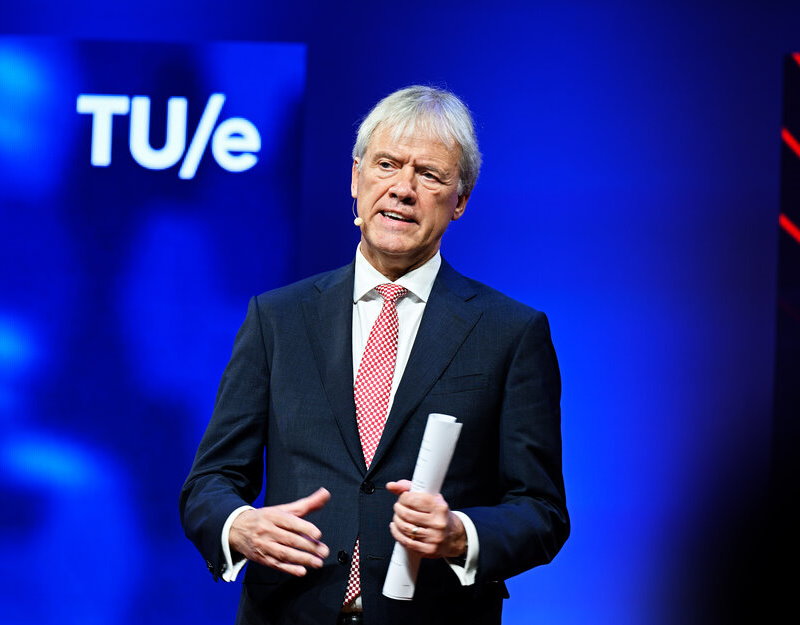
The Western chip industry: fat, dumb and spoiled
“There’s no long-term vision, no long-term focus. If I sometimes look at our society, I have the feeling that we’re fat, dumb and happy,” said ASML CEO Peter Wennink during the opening of the academic year at Eindhoven University of Technology. He probably meant “fat, dumb and spoiled,” but his PR staff must have said: better make it “happy” or the whole country will mock you.
The words “happy” and certainly “spoiled” may well be used to express the state of the industry Wennink is working in. Semiconductor companies are among the most profitable companies, yet governments are pampering powerful players like Intel and TSMC with billions in subsidies. Blinded by the anti-China rhetoric from Washington, politicians and industry think the race can be won by pumping taxpayer money into nanofabs, but in doing so, they’re ignoring a large part of the playing field.

While all media attention is focused on the current squeeze that China is experiencing for manufacturing the most advanced chips – again this week with Huawei’s new cell phone – the country is steadily strengthening its infrastructure for mature semiconductor manufacturing. Once the machines for the ‘old’ chip nodes are up and running, industry competitors will start to feel the heat.
After an unparalleled three decades in which the entire world moved its electronics assembly to China, we’re witnessing an era in which the country is increasingly taking charge of chip manufacturing as well. Just look at the way it’s investing in knowledge and companies, and add to that a strong motivation: the desire to become independent of the US and its vassals, EU and Japan. From this follows inexorably the conclusion that China is getting ready to flood the world with cheap chips.
All about systems
It’s well known that China is working toward technological independence. Behind the scenes, the Chinese government and industry are currently striving to be self-sufficient at the 28nm node. This is coming along pretty nicely.
What’s so special about 28 nm? With this generation of chip technology, reasonably complex chips can be made at a good price. It’s fair to say that the price-quality ratio of this technology is excellent. You can fit quite a lot of features on a 28nm chip – more than enough for most applications. If you take a more aggressive production technology, the cost per chip immediately goes up by as much as fifty percent. It does require immersion scanners from ASML or Nikon, but not the top-of-the-line machines subject to export restrictions.
It’s all about systems, not about chips. If you want to make complex systems, the disadvantage of less aggressive chip technology can be partially compensated by combining several chips. In some cases, that actually increases performance. You can make more complex systems not only by putting more on a chip but also by dividing functions and packaging things cleverly.
Huawei
Leading machine suppliers are involved in China to set up an ecosystem for this purpose. Equipment builders there are already showing that they can deliver quality. They also do so at low prices. Even in lithography, the Chinese are making steady progress. I-line lithography machines from Shanghai Micro Electronics Equipment Group (SMEE) are already running at major backend players, where they help in the chip packaging process. With details of a few microns, this isn’t yet the technology needed to reliably make chips, but these machines are cheap and remarkably reliable.
A key member of the 28nm self-sufficiency group is Huawei. A few years ago, it set up Hubble Technology Investment Co. to fund or buy out crucial industry players. Developers of EDA tools and builders of chip packaging machines are among the target companies.
With the half-billion-dollar Hubble investment vehicle, Huawei acquired 45 domestic tech companies in 2022, double the previous year’s figure. More than two-thirds of the investments went to semiconductor-related suppliers, ranging from chip developers and design tools to manufacturing equipment and materials, a survey conducted by Nikkei Asia showed.
Everything here is focused on self-reliance. Huawei apparently sees these investments as crucial to survival. So it’s working with Quliang Electronics, which is helping with advanced designs for chip assembly and testing chip stacks and packaging. With smart packaging, they aim to create systems made up of chips from more mature nodes that can compete with ICs from advanced nodes. Huawei’s marquee phone presented this week shows that we must take these efforts very seriously.
By the way, Huawei’s recruitment is also very aggressive. We frequently hear from experts in the Dutch semicon ecosystem that they’ve been approached by the Chinese company with princely offers. Nikkei Asia recently reported that Huawei is also recruiting at back-end suppliers such as Taiwan’s ASE Technology, the market leader in chip packaging and testing services.
China’s appetite for lithography
Meanwhile, Chinese manufacturers are steadily building fabs. They completed countless factory buildings in recent years, without being able to fill them with equipment. While discussing ASML’s latest quarterly results, CEO Wennink said the litho giant can’t even fill half of the orders from China. But with the rest of the world dragging its feet, the Chinese see their chance to accelerate.
Last week, the Financial Times reported that Chinese customs data from last June and July showed chip-making equipment imports totaling nearly 5 billion dollars. That was 70 percent more than the 2.9 billion dollars in the same period last year, according to the newspaper. Besides the Netherlands (Besi, ASM, ASML), most of that came from Japan. Both countries imposed export restrictions on their machine and material manufacturers at the urging of the US to slow the Chinese down technologically.
In other parts of the world, chipmakers pushed back the receipt of DUV orders over the past six months. Delaying EUV production is also causing delays in DUV immersion and dry machines. After all, in a 7, 5 or 3nm plant, many more DUV than EUV scanners are needed to produce the many interconnect layers on top of the critical transistor foundation.
China’s appetite for lithography is reflected in the figures of ASML as well. Its 38-billion-euro order book is filled for one-fifth with requests from China. While in the first quarter of this year, ASML was still supplying 427 million euros worth of machines to Chinese factories, in the second quarter it totaled 1.35 billion euros, almost three times as much. The number of EUV machines fell from 17 to 12 from quarter to quarter. The number of immersion machines increased by 14 over the same period, from 25 to 39. In addition, ASML pulled off a final sprint to ship as many machines as possible to the East before the deadline provided by the Dutch government expired.
Manufacturers in China received the extra supply of machines with open arms. “In 2021 and 2022, we had screaming customers,” Peter Wennink said in ASML’s last earnings call. “We simply couldn’t ship. And China was one of the real victims. Now, of course, with the fabs being ready there, the pedestals being there, anything that doesn’t ship to any other country goes to China.” According to Wennink, the demand for lithography from Veldhoven continues to exceed the numbers the litho giant can produce.
Note that it’s not all Chinese manufacturers that produce chips in that country. About half of the IC manufacturing capacity in China is in foreign hands, like TSMC’s megafab in Nanjing.

China’s manufacturing clout
With the US sanctions and American companies’ desire to hedge their bets, electronics assembly is increasingly moving to surrounding countries such as Malaysia, Thailand and Vietnam. Expectations are particularly high about India. The country now has as many inhabitants as China, and half a billion Indians may be added this century. So far, though, with its problems of infrastructure and bureaucracy, India hasn’t really been a successful manufacturing location.
Martin Wolf, chief economics commentator at the Financial Times, recently said on the New York Times’ Ezra Klein podcast that China will continue to play a central part in global supply chains for the foreseeable future, although more countries in Southeast Asia will play a role. China’s manufacturing clout is still enormous. It puts together 19 out of 20 iPhones. There’s a shift to Vietnam and India; within a few years, these countries will make one out of four phones for Apple. But China continues to play a central role, and Wolf says that’s because it now houses large OEMs in leading industries. For example, China is now the largest manufacturer of cars and is strong in renewable energy technology, such as solar cells. With a growing base of end producers and a large internal market, it can be concluded that the country isn’t likely to relinquish its position to neighboring countries any time soon.
Western companies may have a desire to rethink their choice of production sites to avoid being swallowed up by China, but Wolf believes that this will mainly lead to greater diversification of sites in Asia rather than a return of production to Europe and the US. China will take the central stage here. “Removing China altogether, given the immense efficiency of its productive systems, the concentration and agglomeration of skills in particular areas – removing China altogether just seems, to me, wildly infeasible,” Wolf said.
Japanese dominance
“One thing is certain,” a Chinese journalist recently disclosed, “China is preparing to disconnect from the US.” But all indications are that it will not stop at this decoupling. Cheap chips from the East will also begin to undercut the often very generous margins of Western chip manufacturers.
This holds not only for players at the mature nodes but also to manufacturers of advanced chips. In addition to their high-end portfolio (such as microprocessors, memories and FPGAs), these also make chips from mature generations (or have them produced by TSMC at a high price). The shrinking of margins throughout the supply chain will directly impact semicon companies’ investments in advanced technology.
China’s push for technological independence in chips and its response to US restrictions is very reminiscent of the Japanese initiatives of the late 1970s. Back then, GCA, the then-market leader in wafer steppers, shocked the Japanese by giving American customers priority in supplying lithographic machines in a resurgent market. The Japanese government was already spearheading a technological catch-up, and the boycott provided additional motivation for the country’s semiconductor industry to set up its own chip machine business. The result was that Japanese chip manufacturers began to collaborate intensively with their compatriots who built chip production machines. Within five years, they dominated the memory chip market, and since the mid-1980s, Nikon and Canon took over from GCA. That marked the start of fifteen years of Japanese dominance in lithography.
If there are lessons to be learned from this history, the current Chinese march into mature chips means that the country will flood the world with low-cost chips in the next decade. Spoiled Western chip companies will see the very comfortable margins on their products melt away and, in some cases, will close their factories. China is changing from the world’s workshop into the world’s chip factory. In any case, it will considerably shake up the fat, dumb and happy chip industry.





